Isis Hibiscus Sun Tea Recipe
Written by Felicia Cocotzin Ruiz
Photographed by Nicky Hedayatzadeh and Juliet Blankespoor
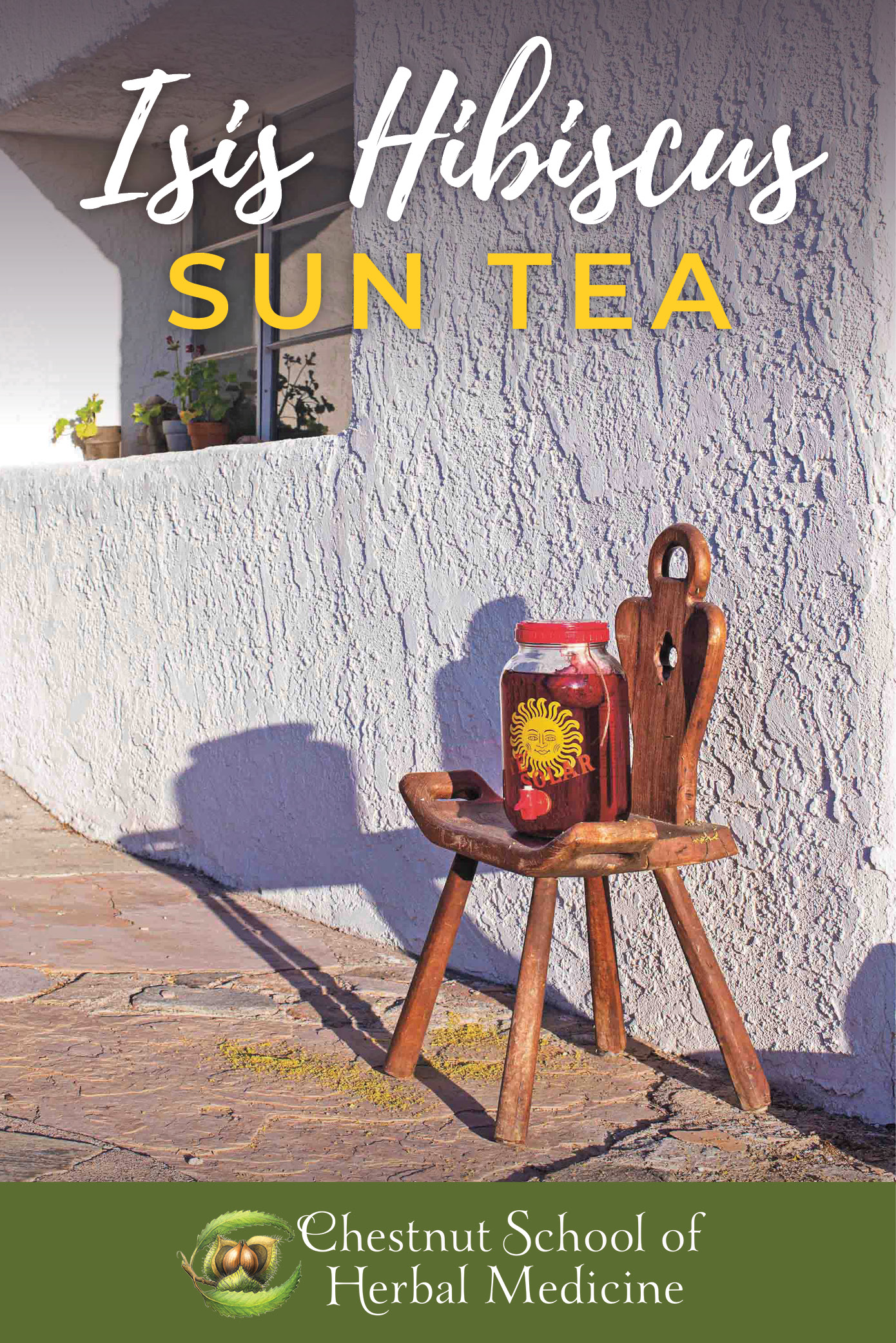
During the Sonoran Desert’s summer monsoon season—the time of year when finding a shaded parking spot feels competitive—I seek out and make an array of cold beverages to stay hydrated. Living in Phoenix, commonly known as the Valley of the Sun, we regularly reach temperatures well over 115°F, putting into motion our summer plans. Not vacation plans, but summer plans. Friends and family members share new ideas with one another on tips for staying cool and we fill in new Phoenicians (who are primarily moving here from California) with tips we’ve learned along the way. Tips such as driving with a cooler in the car for the sole purpose of transporting ice cream, fish, or other delicate food stuffs while running errands, placing a beach towel on the seat of your car so you don’t get a first-degree burn, and never leaving the house without a beverage to stay well hydrated are all parts of our summer plans.
We bring water and other drinks everywhere we go, especially after hearing of visitors ending up in the hospital from heat-related illnesses or, worse, heat stroke. Many of us freeze plastic water bottles to hand out to the unsheltered people who are surviving in this heat, seeking out shade for their bodies instead of cars. Dehydration sneaks up on you and it happens when you lose more fluid than you take in, which can impact how your body functions. Just being slightly dehydrated can lead to fatigue and headaches.
That said, many of us remind each another to stay hydrated all summer long. We acknowledge hydration by incorporating it into our greetings and goodbyes by saying things like, “See you later, stay hydrated!” So, when I’m feeling bored staying hydrated with water, I shake things up with herbal favorites like strawberry-basil lemonade, salty ayran, a mint-yogurt drink I buy from the downtown Lebanese market, and sweet iced agua de flor de jamaica which can be found in many of our Mexican food stores and restaurants.
–
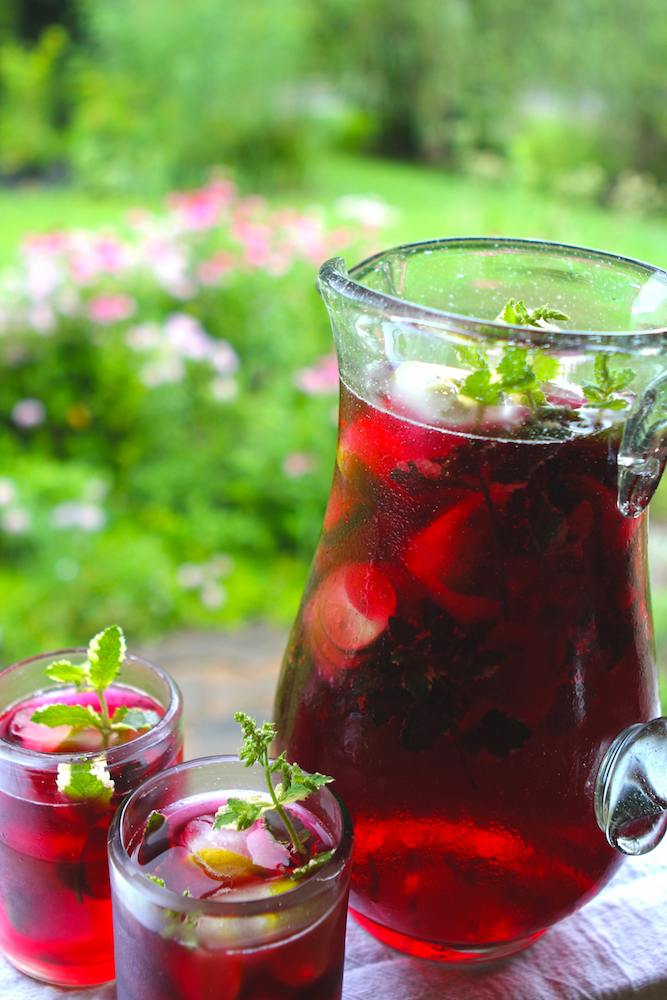
Iced hibiscus mint tea. Photo by Juliet Blankespoor
–
Iced jamaica, or iced hibiscus (Hibiscus sabdariffa) tea, transports me to being four years old, camping on Rocky Point Beach in a 1960’s orange Volkswagen bus with my parents and older brother (what I would do to have that VW bus now!). Rocky Point in the seventies was a not-so-touristy Mexican beach located on the Sea of Cortez, just three hours south of Phoenix. My family would caravan down there with a few of our close friends to camp and go sea fishing for an inexpensive family vacation. Looking back, it was really going from one hot desert to another, but at least Rocky Point had a beach. Those warm days collecting seashells, clamming with my brother, eating fresh tortillas, and drinking sweet red flower water like a little hummingbird are especially fond memories.
As a child, having your parents buy you brightly colored red hibiscus tea from a wooden stall was a real treat because it was often made with a heavy hand of piloncillo syrup, a Mexican raw sugar syrup with earthy notes of smoke and rum. It was Mexican Kool-Aid. This concoction was even more exciting if the vendor included a small chunk of the raw piloncillo at the bottom of your glass to fish out with your hand like a cheap prize in a cereal box.
It was not until my mid-twenties, when I started learning to make herbal preparations, that I realized how astringent a hibiscus infusion actually tastes without the addition of sugar. It’s a different drink altogether, and does not evoke memories of the beach! Making my mouth go dry, it tasted like raw cranberries and unripe persimmons. A spoonful of piloncillo definitely makes the hibiscus go down!
–
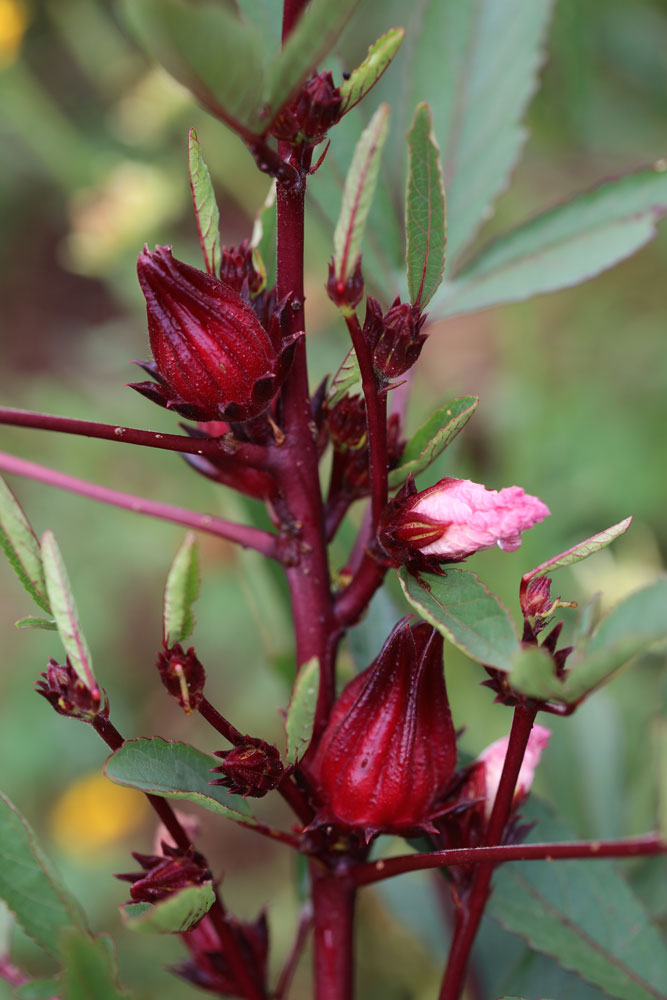
Roselle hibiscus (Hibiscus sabdariffa). Photo by Juliet Blankespoor
–
During this time, I was really beginning to dive deep into food and herbs as medicine, including those used in Ayurveda. And from what I was learning, hibiscus is said to have a cooling effect on the body. This information resonated with me because in Mexican folk herbalism, which I was more familiar with, hibiscus flowers have long been used to treat everything from high blood pressure to a weakened immune system. Traditionally, hibiscus tea is served hot, usually brewed with a cinnamon stick (Cinnamomum verum) and ginger (Zingiber officinale) if you have a cold, or served iced and sweet to cool a fiery body. When I enjoy iced hibiscus tea now, I feel like a little girl and a Mexican grandmother at the same time. Red Mexican Kool-Aid and medicina walking hand-in-hand.
The following is an excerpt from my book, Earth Medicines: Ancestral Wisdom, Healing Recipes, and Wellness Rituals from a Curandera, taken from the “Fire” chapter. It’s an easy recipe for iced hibiscus tea using fresh mint (Mentha spp.) and dried rose petals (Rosa spp.), harnessing the power of the Sun. I call it Isis Sun Tea. It’s not a “traditional” Mexican recipe as it includes rose petals. So, if you find yourself without rose petals in your herbal pantry, simply omit them until next time. The rose petals are a nod to the Egyptian goddess, Isis, who is said to have loved magical healing and flowers such as roses. The mint, however, is very common in Mexican folk herbalism to cool a warm body and is often paired with hibiscus flowers.
–
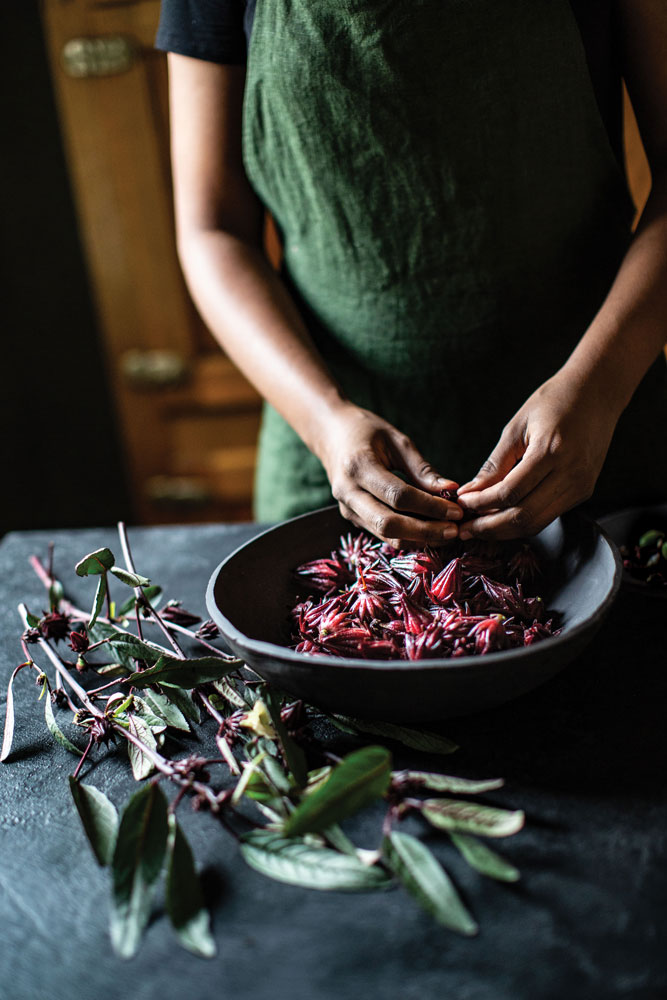
Separating-hibiscus crowns from their ovaries. Photo by Juliet Blankespoor
–
Hibiscus sabdariffa, originally from Africa, is prepared all over the world, especially in warm climates such as Egypt, India, and Mexico. Some cultures drink it for celebrations and others drink it simply to cool off. In my recipe, I suggest sweetening your tea with honey, but if you want to try piloncillo as I mention above, please do! It’s usually sold in Mexican grocery stores and international markets, and also goes by the name panela as it’s called in Colombia, or jaggery, which is very similar to piloncillo and consumed all over the Indian Subcontinent, Southeast Asia, and Africa. Piloncillo is most often sold wrapped in plastic and looks like a giant cone of sacred incense. If you choose to make the tea with piloncillo instead of honey, just be prepared to dissolve it following the manufacterer’s directions.
When I prepare Isis Sun Tea, I like to make a big batch in a gallon glass jar to have on hand for guests and to freeze in ice cube trays to flavor my waters for those hot drives in the car. It’s super refreshing and looks like a fancy mocktail.
Precautions and Contraindications: Roselle has a high safety profile, as it is widely consumed as a food and daily beverage. However, like acidic citrus, it can aggravate heartburn, and may be too cooling for folks who run cold. Hibiscus has been shown to increase the urinary excretion of acetaminophen (Tylenol is a common brand). As a precaution, wait three hours after taking acetaminophen before ingesting hibiscus.1 Hibiscus reduces the absorption of chloroquine (antimalarial, amebicide, and immunosuppressive pharmaceutical).2 As a diuretic and hypotensive herb, hibiscus could potentially compound the effects of pharmaceuticals with similar actions; however, no studies have examined this compounding action.
Isis Sun Tea
Isis is an Egyptian goddess associated with the sun and is believed to be a messenger of solar power. Often depicted with a solar disc on her head, she is known as the Radiant Goddess or Lady of the House of Fire and is a protective goddess who uses magic spells to help others in need. Responsible for the rising of the sun, she is said to love flowers, water, and honey, which are three of the ingredients needed to make this delicious hibiscus solar tea.
Here in the Southwest, many of us of Mexican descent grew up drinking a tart hibiscus beverage known as agua de flor de jamaica, made from the dried calyces of the roselle flower. It was and still is one my favorite beverages to enjoy on a really hot day and it doesn’t hurt that it’s full of antioxidants. The main ingredient in Isis Sun Tea are the calyces of the Hibiscus sabdariffa shrub, also known as roselle or by its common name, hibiscus. The calyces can be found at most international grocers. (To grow your own, see the Chestnut School’s article on The Medicinal Benefits of Hibiscus). When I want to channel more fire, more sun, and more magical Isis energy, I remember to place my sun tea jar of hibiscus out to infuse on a bright sunny day.
Ingredients:
- ½ cup dried hibiscus flowers (Hibiscus sabdariffa)
- 2 Tablespoons dried rose petals (Rosa spp.)
- Few sprigs of fresh mint (Mentha spp.)
- Honey
Yield: About 12 cups
Put the hibiscus flowers, rose petals, and mint in a square of cheesecloth or a nut milk bag, making a little bundle. Add the herb bundle to a glass gallon jar. Fill with water. Place the jar out in the direct sun for a few hours. Remove the herb bundle and sweeten the tea with honey to taste.
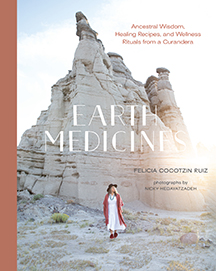 From Earth Medicines: Ancestral Wisdom, Healing Recipes, and Wellness Rituals from a Curandera by Felicia Cocotzin Ruiz © 2021 by Felicia Cocotzin Ruiz. Photographs © 2021 by Nicky Hedayatzadeh. Reprinted in arrangement with Roost Books, an imprint of Shambhala Publications, Inc. Boulder, CO. www.roostbooks.com.
From Earth Medicines: Ancestral Wisdom, Healing Recipes, and Wellness Rituals from a Curandera by Felicia Cocotzin Ruiz © 2021 by Felicia Cocotzin Ruiz. Photographs © 2021 by Nicky Hedayatzadeh. Reprinted in arrangement with Roost Books, an imprint of Shambhala Publications, Inc. Boulder, CO. www.roostbooks.com.
–
References
- American Herbal Products Association’s Botanical Safety Handbook, 2nd ed. CRC Press; 2013.
- Mahmoud BM, Ali HM, Homeida MM, and Bennett JL, 1994. “Significant Reduction in Chloroquine Bioavailability following Coadministration with the Sudanese Beverages Aradaib, Karkadi, and Lemon.” Journal of Antimicrobial Chemotherapy33(5): 1005–1009.
Meet Our Contributors:

FELICIA COCOTZIN RUIZ is a native Arizonan, living in one of the most edible and medicinal landscapes in the world. Following her family’s lineage, Felicia began training as a curandera (medicine woman) in her early twenties, working in cafes and coffee shops to make ends meet. Eventually Felicia would find success as an award-winning restaurateur, and later join over twenty-five years of Indigenous healing practices with food as medicine.
Recognized for her work with Indigenous foodways and decolonizing wellness, Felicia is passionate about sharing food + lifestyle as medicine across many platforms. Her book Earth Medicines: Ancestral Wisdom, Healing Recipes, and Wellness Rituals from a Curandera, has received praise from industry leaders including Padma Lakshmi, Dana Cowin, and Julia Turshen. Felicia’s work has been featured in Spirituality & Health, Forbes, Bon Appétit, and several other media outlets including The Original Americans episode on Padma Lakshmi’s Taste The Nation (Hulu). Felicia presents frequently around the country on traditional healing practices, culinary medicine, holistic wellness, and Native American food sovereignty for nonprofits, universities, and museums–including the Smithsonian National Museum of the American Indian.

JULIET BLANKESPOOR is the founder, primary instructor, and Creative Director of the Chestnut School of Herbal Medicine, an online school serving thousands of students from around the globe. She's a professional plant-human matchmaker and bonafide plant geek, with a degree in botany and over 30 years of experience teaching and writing about herbalism, medicine making, and organic herb cultivation. Juliet’s lifelong captivation with medicinal weeds and herb gardening has birthed many botanical enterprises over the decades, including an herbal nursery and a farm-to-apothecary herbal products business.
These days, she channels her botanical obsession through her writing and photography in her online programs, on her personal blog Castanea, and in her new book, The Healing Garden: Cultivating and Handcrafting Herbal Remedies. Juliet and her family reside in a home overrun with houseplants and books in Asheville, North Carolina.
Interested in becoming a contributor?
© Chestnut School of Herbal Medicine and chestnutherbs.com, 2011-2023. Unauthorized use and/or duplication of this material without express and written permission from this site’s author and/or owner is strictly prohibited. Excerpts and links may be used, provided that full and clear credit is given to Chestnut School of Herbal Medicine and chestnutherbs.com with appropriate and specific direction to the original content.
Want to take a deeper dive into medicinal herbs and their uses?
Our 1,000-hour Herbal Immersion Program is the most comprehensive handcrafted online herbal course available, covering botany, foraging, herb cultivation, medicine making, and therapeutics.
The post Isis Hibiscus Sun Tea Recipe appeared first on Chestnut School of Herbal Medicine.

Leave a Reply